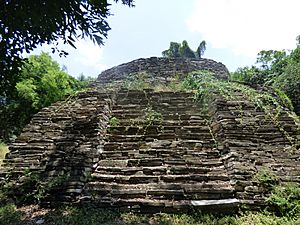El Sabinito facts for kids
El Sabinito is an ancient ruin from the time before Christopher Columbus arrived in the Americas. It was built by the Huastec civilization, a group of people who lived in Mexico long ago. You can find El Sabinito in the Mexican state of Tamaulipas. It's about 25 kilometers southwest of Soto la Marina and 96 kilometers east of Ciudad Victoria. El Sabinito, along with another site called Balcon de Montezuma, marks the very northern edge of a large cultural area known as Mesoamerica.
Contents
Discovering El Sabinito
El Sabinito was found in 1987 by a person named Aureliano Medina. This area of Tamaulipas is known for its untouched tropical jungles and very humid weather. Today, the site is located within the Soto la Marina area, just north of the Sierra de Tamaulipas mountains.
Compared to other Huastec ruins in Tamaulipas, like Balcon de Montezuma and the Pyramid of Tammapul, El Sabinito was a much bigger and more important city.
History of the Huastec People
The Huastecs of Tamaulipas originally came from the Mayan culture. They moved north to this area around 1300 BCE. When they arrived, the Huastecs tried very hard to keep their Mayan traditions alive. They managed to keep their identity for about a thousand years. However, by 300 CE, they started to mix some parts of their nomadic neighbors' cultures into their own.
Even though archaeologists have found signs of human activity near the Soto la Marina River as far back as 10,000 BCE, the Huastecs only started building and living at El Sabinito around 200 CE. The city began to show signs of decline around 1000 CE. By 1300 CE, all signs of life at the site disappeared, meaning it was abandoned. We don't know why they left the city.
Life in El Sabinito
El Sabinito was a town with more than 600 building foundations. Archaeologists from Mexico believe that over 2,500 people lived in El Sabinito when it was at its busiest. This is based on finding 600 homes within those foundations.
The city was built on top of the tallest of several hills. It had strong terraces and walls. This suggests that El Sabinito might have been a good place to watch for enemy nomadic tribes. So, it was likely a military and political center, as well as a place where people lived and shared their culture.
Amazing Architecture
All the buildings at El Sabinito are very well preserved. As mentioned, archaeologists found over 600 foundations. These were built on terraces, walkways, and open plazas. Everything was arranged in a balanced way, showing that the builders had advanced knowledge of architecture.
The site can be divided into two main areas, based on its two largest plazas.
Plaza 1
The first plaza is located furthest north. It is surrounded by the largest buildings in El Sabinito. One special building here is a circular pyramid, eight meters tall. It has limestone slabs sticking out from its sides, like the arms of a windmill. This cone-shaped pyramid style is linked to the worship of Ehecatl. Ehecatl was the Huastec god of wind, and later the Aztecs also worshipped him. Across from this pyramid is a ceremonial altar. It measures 2 meters by 6 meters and has an unusual, uneven shape.
Plaza 2
In Plaza 2, you'll see two large, circular twin buildings. They start from the hillside and are connected by a wall with a staircase. This staircase leads up to a ceremonial plaza. You can also reach this plaza using terraces that are surrounded by other buildings.
See also
 In Spanish: El Sabinito para niños
In Spanish: El Sabinito para niños
- La Huasteca
- Mesoamerican architecture
- Archaeology in Mexico
- Tammapul
Images for kids



